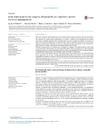Identificador persistente para citar o vincular este elemento:
https://accedacris.ulpgc.es/handle/10553/48459
| Campo DC | Valor | idioma |
|---|---|---|
| dc.contributor.author | Abásolo, Ignacio | en_US |
| dc.contributor.author | Barber Pérez, Patricia Lucía | en_US |
| dc.contributor.author | González López-Valcárcel, Beatriz | en_US |
| dc.contributor.author | Jiménez, Octavio | en_US |
| dc.contributor.other | Abasolo, Ignacio | - |
| dc.contributor.other | Barber, Patricia | - |
| dc.contributor.other | Valcarcel, Bea | - |
| dc.date.accessioned | 2018-11-23T21:59:47Z | - |
| dc.date.available | 2018-11-23T21:59:47Z | - |
| dc.date.issued | 2014 | en_US |
| dc.identifier.issn | 0213-9111 | en_US |
| dc.identifier.uri | https://accedacris.ulpgc.es/handle/10553/48459 | - |
| dc.description.abstract | Objectives: In Spain, official information on waiting times for surgery is based on the interval between the indication for surgery and its performance. We aimed to estimate total waiting times for surgical procedures, including outpatient visits and diagnostic tests prior to surgery. In addition, we propose an alternative system to manage total waiting times that reduces variability and maximum waiting times without increasing the use of health care resources. This system is illustrated by three surgical procedures: cholecystectomy, carpal tunnel release and inguinal/femoral hernia repair. Methods: Using data from two Autonomous Communities, we adjusted, through simulation, a theoretical distribution of the total waiting time assuming independence of the waiting times of each stage of the clinical procedure. We show an alternative system in which the waiting time for the second consultation is established according to the time previously waited for the first consultation. Results: Average total waiting times for cholecystectomy, carpal tunnel release and inguinal/femoral hernia repair were 331, 355 and 137 days, respectively (official data are 83, 68 and 73 days, respectively). Using different negative correlations between waiting times for subsequent consultations would reduce maximum waiting times by between 2% and 15% and substantially reduce heterogeneity among patients, without generating higher resource use. Conclusion: Total waiting times are between two and five times higher than those officially published. The relationship between the waiting times at each stage of the medical procedure may be used to decrease variability and maximum waiting times | en_US |
| dc.language | spa | en_US |
| dc.publisher | 0213-9111 | |
| dc.relation.ispartof | Gaceta Sanitaria | en_US |
| dc.source | Gaceta Sanitaria[ISSN 0213-9111],v. 28, p. 215-221 | en_US |
| dc.subject | 531207 Sanidad | en_US |
| dc.subject.other | Listas de espera | en_US |
| dc.subject.other | Sistema sanitario español | en_US |
| dc.title | Real waiting times for surgery: proposal for an improved system for their management | en_US |
| dc.title.alternative | Los tiempos de espera reales en cirugía. Propuesta de un sistema mejoradopara su gestión | en_US |
| dc.type | info:eu-repo/semantics/Article | en_US |
| dc.type | Article | en_US |
| dc.identifier.doi | 10.1016/j.gaceta.2013.10.011 | |
| dc.identifier.scopus | 84899994232 | - |
| dc.identifier.isi | 000335714700007 | - |
| dcterms.isPartOf | Gaceta Sanitaria | |
| dcterms.source | Gaceta Sanitaria[ISSN 0213-9111],v. 28 (3), p. 215-221 | |
| dc.contributor.authorscopusid | 6602352170 | - |
| dc.contributor.authorscopusid | 7102119002 | - |
| dc.contributor.authorscopusid | 6507677112 | - |
| dc.contributor.authorscopusid | 55992015700 | - |
| dc.description.lastpage | 221 | - |
| dc.description.firstpage | 215 | - |
| dc.relation.volume | 28 | - |
| dc.investigacion | Ciencias Sociales y Jurídicas | en_US |
| dc.type2 | Artículo | en_US |
| dc.identifier.wos | WOS:000335714700007 | - |
| dc.contributor.daisngid | 2369703 | - |
| dc.contributor.daisngid | 3537283 | - |
| dc.contributor.daisngid | 1229412 | - |
| dc.contributor.daisngid | 7008994 | |
| dc.contributor.daisngid | 30959241 | |
| dc.contributor.daisngid | 7388925 | - |
| dc.identifier.investigatorRID | I-7614-2015 | - |
| dc.identifier.investigatorRID | B-4788-2017 | - |
| dc.identifier.investigatorRID | A-9891-2010 | - |
| dc.utils.revision | Sí | en_US |
| dc.contributor.wosstandard | WOS:Abasolo, I | |
| dc.contributor.wosstandard | WOS:Barber, P | |
| dc.contributor.wosstandard | WOS:Lopez-Valcarcel, BG | |
| dc.contributor.wosstandard | WOS:Jimenez, O | |
| dc.date.coverdate | Enero 2014 | |
| dc.identifier.ulpgc | Sí | es |
| dc.description.sjr | 0,442 | |
| dc.description.jcr | 1,186 | |
| dc.description.sjrq | Q3 | |
| dc.description.jcrq | Q3 | |
| dc.description.scie | SCIE | |
| dc.description.ssci | SSCI | |
| item.fulltext | Con texto completo | - |
| item.grantfulltext | open | - |
| crisitem.author.dept | GIR Economía de la salud y políticas públicas | - |
| crisitem.author.dept | Departamento de Métodos Cuantitativos en Economía y Gestión | - |
| crisitem.author.dept | GIR Economía de la salud y políticas públicas | - |
| crisitem.author.dept | Departamento de Métodos Cuantitativos en Economía y Gestión | - |
| crisitem.author.orcid | 0000-0001-8904-8358 | - |
| crisitem.author.orcid | 0000-0002-5571-3257 | - |
| crisitem.author.parentorg | Departamento de Métodos Cuantitativos en Economía y Gestión | - |
| crisitem.author.parentorg | Departamento de Métodos Cuantitativos en Economía y Gestión | - |
| crisitem.author.fullName | Barber Pérez, Patricia Lucía | - |
| crisitem.author.fullName | González Lopez-Valcarcel, Beatriz | - |
| Colección: | Artículos | |
Citas SCOPUSTM
10
actualizado el 08-jun-2025
Citas de WEB OF SCIENCETM
Citations
9
actualizado el 08-jun-2025
Visitas
88
actualizado el 12-oct-2024
Descargas
97
actualizado el 12-oct-2024
Google ScholarTM
Verifica
Altmetric
Comparte
Exporta metadatos
Los elementos en ULPGC accedaCRIS están protegidos por derechos de autor con todos los derechos reservados, a menos que se indique lo contrario.
